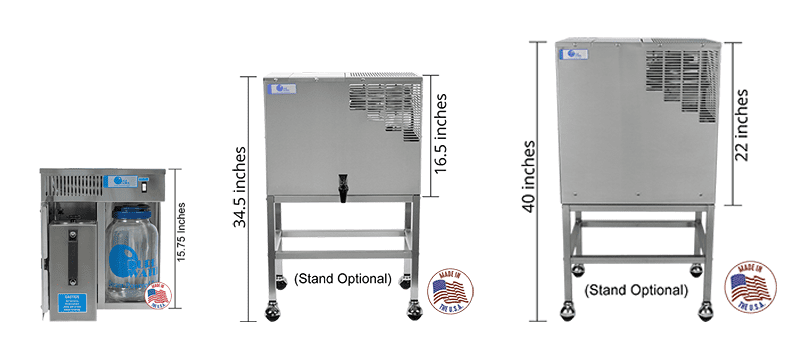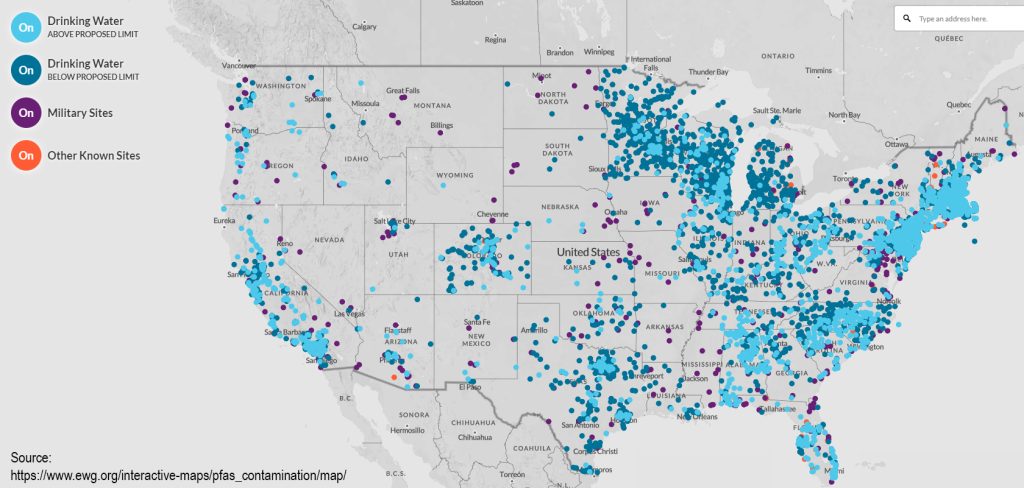There has been a lot of confusion regarding PFCs and PFASs, and this is largely because the abbreviation PFCs can stand for two different things:
- Perfluorinated Chemicals: This is a term that some scientists use to refer to the group of toxic chemicals called per- and polyfluoroalkyl substances (PFASs). The EPA is now trying to use “per- and polyfluoroalkyl substances (PFASs)” rather than “perfluorinated chemicals (PFCs)” consistently to collectively describe PFOA, PFOS and the other chemicals in this group.
- Perfluorocarbons: This is a subset of perfluorinated chemicals.
Perfluorocarbons are not toxic, and there are no direct health effects associated with exposure to them. However, perfluorocarbons are among the most potent and longest-lasting type of greenhouse gases emitted by human activities.
(Source: https://www.epa.gov/pfas/what-are-pfcs-and-how-do-they-relate-and-polyfluoroalkyl-substances-pfass)
PFAS is a replacement for one of the definitions of PFCS. When it comes to contaminating our water, we do not need to worry as much about the latter type of PFCs. We need to be most concerned about PFASs. These are part of a very large family of chemicals, and one must be careful not to generalize the chemical and physical properties of the entire group.
There are many different types of PFASs, including GenX chemicals and PFBS, which are in use around the world and in the USA, as well as PFOA and PFOS, which the USA has tried to stop using.
What are the Uses of PFAS?
Because PFASs have a wide range of properties, fluorosurfactants are used everywhere. Examples are in teflon, water-resistant textiles, carpeting, upholstery, apparel, stain-resistant fabrics, metal plating, and fire-fighting foam.
The EPA’s website lists:
- Food packaged in PFAS-containing materials, processed with equipment that used PFAS, or grown in PFAS-contaminated soil or water.
- Commercial household products, including stain- and water-repellent fabrics, nonstick products (e.g., Teflon), polishes, waxes, paints, cleaning products, and fire-fighting foams (a major source of groundwater contamination at airports and military bases where firefighting training occurs).
- Workplace, including production facilities or industries (e.g., chrome plating, electronics manufacturing or oil recovery) that use PFAS.
- Drinking water, typically localized and associated with a specific facility (e.g., manufacturer, landfill, wastewater treatment plant, firefighter training facility).
- Living organisms, including fish, animals, and humans, where PFASs have the ability to build up and persist over time.
There are thousands of chemicals formed from fluorinated organic chemicals referred to as PFASs. PFOA and PFOS are the two types that have been the most extensively produced and studied. These have mainly been used to make carpets, clothing, fabrics for furniture, paper packaging for food, and other materials (e.g. cookware) that are resistant to water, grease, or stains. They are also used for firefighting at airfields and in a number of industrial processes.
Scientists have found PFOA and PFOS in the blood of nearly all the people they tested. Drinking water is a source in the small percentage of communities where these chemicals have contaminated water supplies. A common culprit is water supplies close to an airfield where these chemicals were used for firefighting.
Source: https://www.epa.gov/pfas/basic-information-pfas
EPA Acceptable Level for PFAS?
To provide Americans, including the most sensitive populations, with a margin of protection from a lifetime of exposure to PFOA (Perfluorooctanoic acid) and PFOS (Perfluorooctane-sulfonic acid) from drinking water, the EPA established the health advisory levels at 70 parts per trillion.
When both PFOA and PFOS are found in drinking water, the combined concentrations of PFOA and PFOS should be compared with the 70 parts per trillion health advisory level. This health advisory level offers a margin of protection for all Americans throughout their life from adverse health effects resulting from exposure to PFOA and PFOS in drinking water.
Source: https://www.epa.gov/ground-water-and-drinking-water/drinking-water-health-advisories-pfoa-and-pfos
Pure Water Distillers Remove PFAS from Water
Over 99.9% Removal of all PFAS, including PFOA and PFOS
Best Water Purification Method to Remove PFAS from Water
The Water Research Foundation, a non-profit research organization located in Denver, Colorado, has found that aeration, chlorine dioxide, dissolved air flotation, coagulation, flocculation, sedimentation, granular filtration, and microfiltration were all ineffective for removing PFASs, including PFOA and PFOS.
Granular activated carbon (GAC) was shown to be adept at removing most PFASs, and it may be the average utility’s best bet for PFOA and PFOS contamination.
Source: http://www.waterrf.org/PublicReportLibrary/4322.pdf
Water Treatment Options
Distillation: Water distillation is the gold standard of water purification. Distillation can remove over 99.9% PFAS as well as many other contaminants. (See our Independently Certified Lab Results)
Granular Activated Carbon (GAC) and Ion Exchange Resins: GAC is used for PFAS removal. It works by adsorbing PFAS molecules onto the surface of activated carbon. Although somewhat effective, it requires periodic replacement as its adsorption capacity becomes exhausted. Ion exchange resins, which can be tailored to selectively target PFAS compounds, have also emerged as an possible treatment option. These resins exchange ions in the water with ions attached to the resin, capturing PFAS molecules in the process.
Advanced Oxidation Processes (AOPs): AOPs involve the generation of highly reactive species, such as hydroxyl radicals, which can break down PFAS molecules into less harmful compounds. Methods like UV irradiation combined with hydrogen peroxide or ozone have shown success in degrading PFAS in water.
Membrane Filtration: Techniques such as nanofiltration and reverse osmosis use semi-permeable membranes to physically separate PFAS molecules from water. These methods are highly effective but can be cost-prohibitive for large-scale applications due to energy requirements and the need for frequent membrane maintenance.
Health Effects of Long-Term Exposure
There are several suspected health effects of long-term exposure: These chemicals can affect the developing fetus and child, including possible changes in growth, learning ability, and behavior. These chemicals can also decrease fertility, interfere with the body’s natural hormones, increase cholesterol, affect the immune system, and increase the risk of cancer, thyroid effects, and more.
Recent Efforts to Combat PFAS Contamination
In the last two years, significant strides have been made to combat PFAS contamination in water supplies. Recognizing the urgency of the issue, various governmental and non-governmental organizations have intensified their efforts to address and mitigate the presence of these harmful substances.
Regulatory Actions and Legislation
The U.S. Environmental Protection Agency (EPA) has been at the forefront of these efforts. In 2022, the EPA launched its PFAS Strategic Roadmap, which outlines specific actions and timelines to tackle PFAS pollution. This roadmap aims to establish enforceable drinking water limits for PFOA and PFOS by 2023, with a broader plan to regulate additional PFAS compounds. Furthermore, the EPA has been working on listing PFOA and PFOS as hazardous substances under the Comprehensive Environmental Response, Compensation, and Liability Act (CERCLA), commonly known as Superfund. This classification would facilitate the cleanup of contaminated sites and hold polluters accountable for the costs.
At the state level, several states have enacted their own stringent regulations. For example, Michigan has set maximum contaminant levels (MCLs) for seven different PFAS compounds in drinking water, one of the most comprehensive state-level PFAS standards in the U.S. Other states, such as New Jersey and New York, have also adopted similar measures to protect public health.
Research and Public Awareness
Research efforts have expanded significantly, with numerous studies focusing on understanding the behavior, toxicity, and remediation of PFAS. The National Institutes of Health (NIH) and other research bodies have funded extensive studies to assess the long-term health impacts of PFAS exposure and to develop innovative remediation technologies.
Public awareness campaigns have also been crucial. Organizations like the Environmental Working Group (EWG) and local advocacy groups have played a pivotal role in educating the public about PFAS risks and the importance of water safety. These campaigns have led to increased public pressure on industries and policymakers to take decisive action.
Industry Initiatives and Corporate Responsibility
Industries that have historically used PFAS in their manufacturing processes are now taking steps to reduce and eliminate these substances. Many companies are investing in research to develop safer alternatives to PFAS. For example, major chemical manufacturers have pledged to phase out the production and use of certain PFAS compounds and are collaborating with regulatory agencies to ensure compliance with new standards.
Remove PFAS from Water (Tap or Well Water)
Ultimately, it is up to each individual to decide whether to drink tap water or purify their water to remove contaminants. The reality is that water quality changes daily. A boil alert, a flooding event, a chemical spill, and naturally occurring minerals leeching into the water supply will likely happen. If you care about your food, you should also care about your water. Protect yourself by investing in a Pure Water distiller to remove PFAS from your water.









Note: the 70 ppt is based on calculations and an ‘average’ 176 lb adult. NO ONE REALLY KNOWS!!! We live near airport and have a contaminated well, evidently for 25+ years. One person has had 4 cancers, another an immune disorder and high cholesterol. Is this a coincidence? You want ZERO in your water..
You’re correct! (And good news – we just got the test results back that prove our water distillers remove all PFOA, PFOS, and more from your drinking water.)